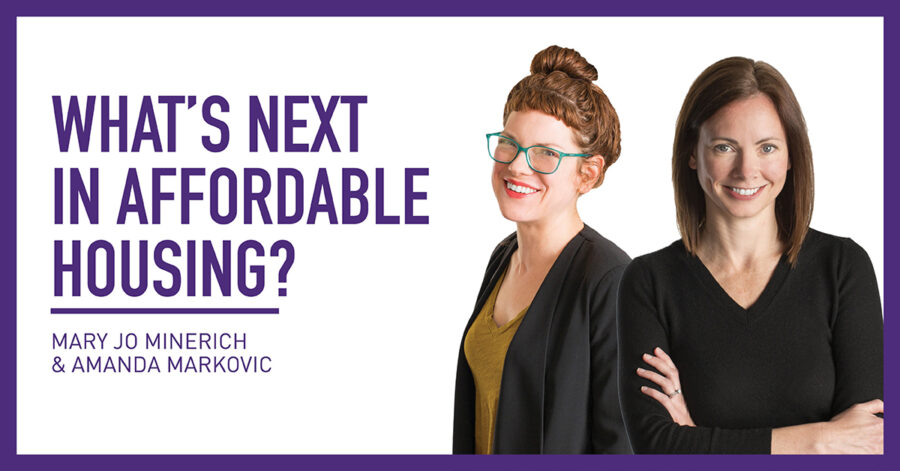Insights
Nov 21, 2023 _ insights
What’s Next in Affordable Housing: GBBN’s Designers Look to 2024
What’s next with affordable housing? As 2023 draws to a close, GBBN’s Mary Jo Minerich and Amanda Markovic, AIA—two designers with a lot of affordable housing experience—sat down to talk about the future. What’s next in terms of trends, technology, construction? See what they say below:
What will affordable housing look like in the coming year? Where is it taking place? Who’s doing it?
We’re seeing affordable housing in a variety of scales and types, with increasing emphasis on sustainable design—from Passive House design to sustainably sourced material selection. The urban core is a big focus of development, though there is also clear interest in surrounding neighborhoods. A big concern is locating housing where jobs are and figuring out the right ways to build. This is part of what it means to build a sustainable, resilient, and equitable community.
What are some emerging trends in terms of how affordable housing is designed and constructed? How are these shaping GBBN’s approach to affordable housing?
Design Matters. It’s encouraging to see that people are expecting affordable housing to make a strong contribution to their neighborhoods rather than just disappearing into the background behind their market rate cousins. And it’s increasingly common to see well-designed, affordable housing projects celebrated for their ability to enrich their neighborhood (see our Willkommen Design Talk).
For designers and developers, this means recognizing opportunities in affordable housing to center people’s needs holistically while responding to the local history, culture, and climate. We’re starting to see more questions about what housing can look like and the responses are far from bland or neutral. As architects, we’re asking how we can communicate the value of residents and communities with a creative approach to program, massing, and materials.
It’s also worth remembering that we’re in an affordable housing crisis. Most cities still face a shortage of tens of thousands of affordable units. Fortunately, public opinion is beginning to shift. Seventy-one percent of Americans now say that growing housing supply and improving housing affordability should be a legislative priority. Designers can do their part in creating housing that works against the stigma that has long been associated with affordable housing. Ultimately, we’re hopeful that public policy will follow public opinion.
Construction. Affordable housing isn’t getting any cheaper or faster to create on its own. Fortunately, designers are figuring out how to leverage technology and craft to deliver a high level of comfort and quality at the required schedule and budget. For instance, at Fifth & Dinwiddie West, we’ve paired prefabrication with sustainable building standards such as Passive House, RESET Air, and Fitwel. Our Willkommen project brings ornamental masonry details into the 21st century with the help of Parametric Design and Augmented Reality. We think this kind of innovation will continue, with intensified focus on cutting carbon emissions and improving buildings’ environmental footprints.
How are the economics of affordable housing changing? What does the real estate and financial landscape look like? And how are people responding?
Looking Beyond the Building. We expect current trends of providing wraparound services at the lowest-income levels and for special needs groups to continue. However, at more moderate-income levels and in smaller buildings, we’re seeing fewer dedicated amenities. Instead, more attention is being paid to how the building positions residents as community members, with full access to neighborhood assets such as libraries, parks, recreation spaces, and transit.
At district levels, we’re seeing zoning incentives that allow greater density or parking exemptions for developments that take significant affordability and sustainability measures, which can really help a project’s bottom line.
We’re also seeing more discussion in our cities and states about the creation of local affordable housing funds, and other ways that local governments, institutions, and professional organizations can support new, small, and minority developers (especially with predevelopment costs). The results thus far are mixed. For example, a State of Ohio policy change recently disallowed the use of Low-Income Housing Tax Credits (LIHTC) and Historic Tax Credits (HTC) on the same project. That made a lot of projects harder, if not impossible. Fortunately, Ohio also created a new affordable housing tax credit program, which may mitigate some of the damage of the previous policy change. Minnesota, on the other hand, recently made a historic, $1 billion investment in affordable housing. So, the situation really depends on where you are.
Opportunities in the IRA. Finally, right now everyone is trying to understand how the Inflation Reduction Act can help fund or improve affordable housing. We recently partnered with CMTA to dig into the legislation and identify the most relevant incentives for multifamily housing. We distilled that information into an interactive tool—our IRA Calculator—which can estimate financing opportunities at stake in different sustainable design decisions. By combining affordable housing incentives with additional incentives for renewable energy, high-performing building assemblies, and other practices that prioritize sustainability, resilience, and equity, the IRA is making hundreds of thousands (if not millions) of dollars available per project.
The IRA is especially exciting because it incentivizes ambitious, holistic thinking about affordable housing. Beyond unit counts, it encourages everyone involved in affordable housing—developers, designers, local officials—to develop high-performing, comfortable housing that enriches its context and contributes to resilient neighborhoods. For those already doing that, it helps close funding gaps. For those that aren’t, it helps open a more visionary path.
 Mary Jo Minerich is an associate at GBBN. Her design approach is rooted in empathy and research. In addition to leading GBBN’s approach to housing research and post occupancy evaluations, she works with clients and design teams to articulate project goals that positively impact community equity and resilience. Mary Jo has leveraged her expertise working in historic districts to facilitate conversations about how these districts can meet tomorrow’s needs while helping us explore our relationship with the past. Some of Mary Jo’s projects include Willkommen, Cincinnati Shakespeare Company’s Otto M. Budig Theater, and YWCA Cincinnati’s Van Antwerp Domestic Violence Shelter.
Mary Jo Minerich is an associate at GBBN. Her design approach is rooted in empathy and research. In addition to leading GBBN’s approach to housing research and post occupancy evaluations, she works with clients and design teams to articulate project goals that positively impact community equity and resilience. Mary Jo has leveraged her expertise working in historic districts to facilitate conversations about how these districts can meet tomorrow’s needs while helping us explore our relationship with the past. Some of Mary Jo’s projects include Willkommen, Cincinnati Shakespeare Company’s Otto M. Budig Theater, and YWCA Cincinnati’s Van Antwerp Domestic Violence Shelter.
 Amanda Markovic, AIA is a principal and Market Design Leader for GBBN’s Mixed-Use Market, which includes multifamily housing, libraries, and more. She is a Blueprint for Better Champion with AIA Pittsburgh and is a frequent presenter at regional and national community design conferences. Her recent work includes Fifth & Dinwiddie West and East, Cincinnati & Hamilton County Public Library’s Deer Park Branch, and Baldwin Burrough Public Library.
Amanda Markovic, AIA is a principal and Market Design Leader for GBBN’s Mixed-Use Market, which includes multifamily housing, libraries, and more. She is a Blueprint for Better Champion with AIA Pittsburgh and is a frequent presenter at regional and national community design conferences. Her recent work includes Fifth & Dinwiddie West and East, Cincinnati & Hamilton County Public Library’s Deer Park Branch, and Baldwin Burrough Public Library.




